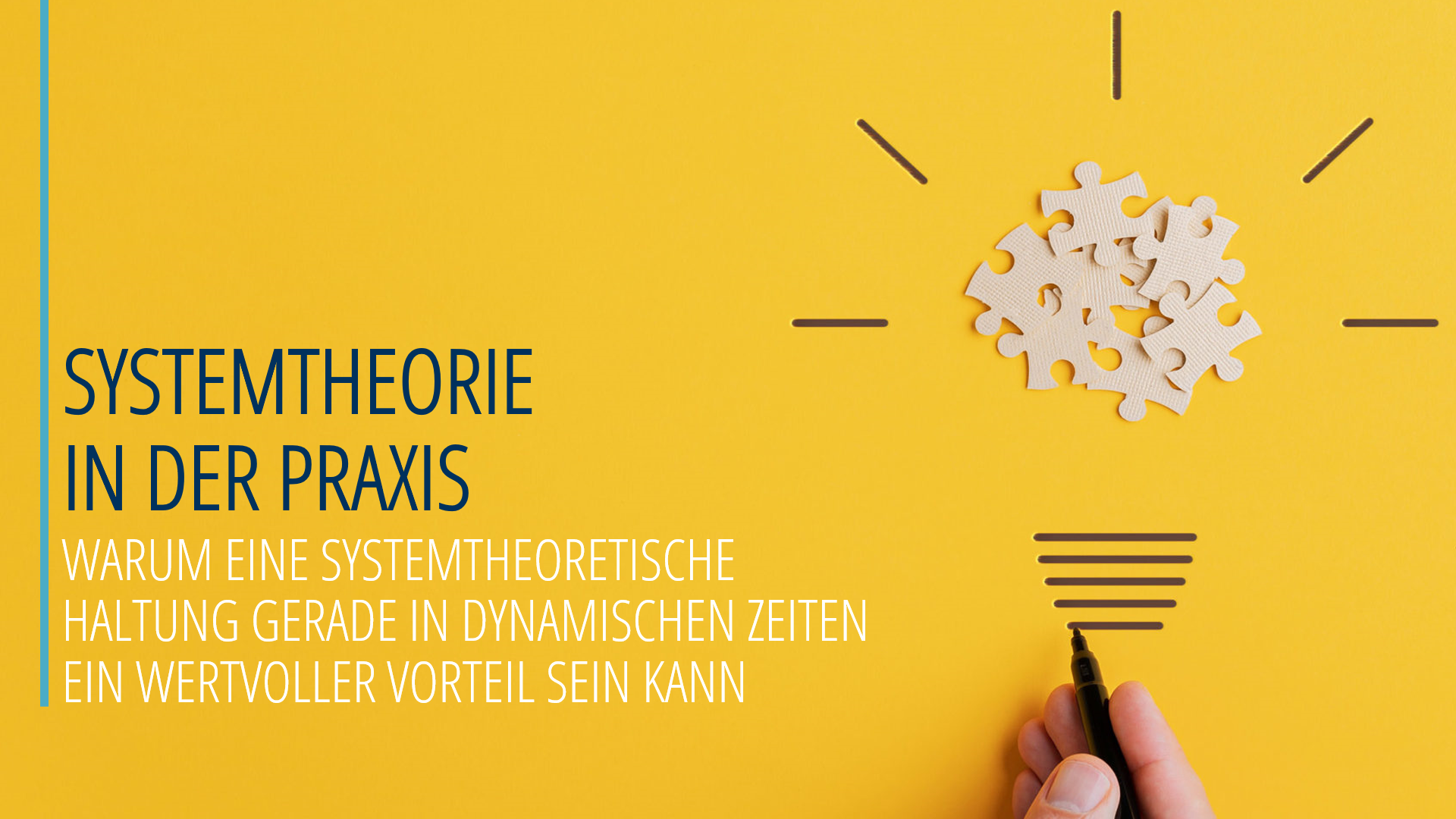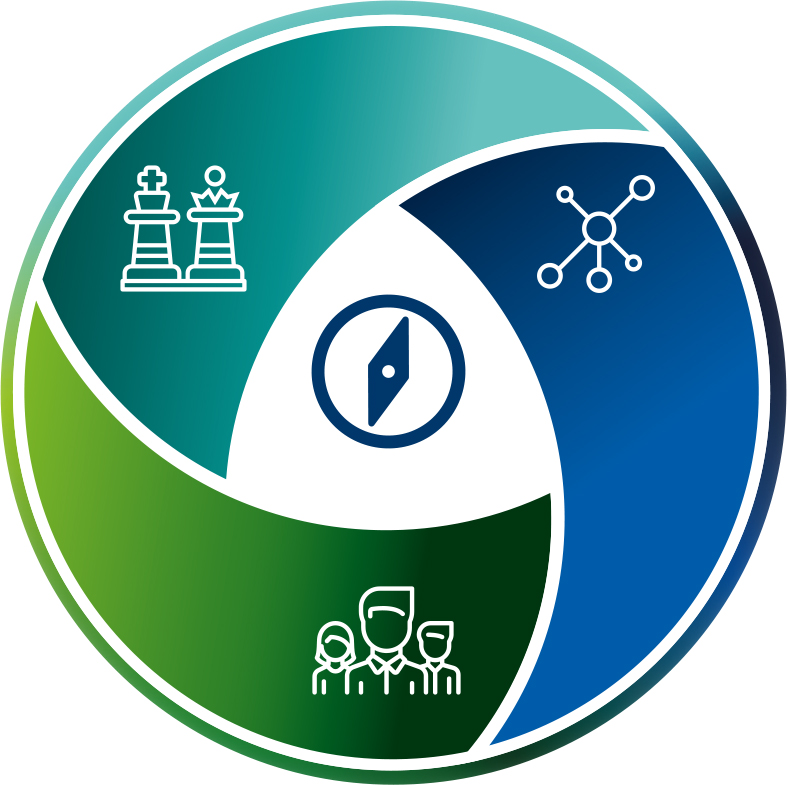SYSTEMS THEORY IN PRACTICE
WHY A SYSTEM-THEORETICAL APPROACH CAN BE A VALUABLE ADVANTAGE ESPECIALLY IN DYNAMIC TIMES
WHY A SYSTEM-THEORETICAL APPROACH CAN BE A VALUABLE ADVANTAGE ESPECIALLY IN DYNAMIC TIMES
In particular the humanists will remember Luhmann and systems theory from their student days. While systems theory was usually perceived at university as a rather dry topic with little applicability in practice, a systemic approach to everyday business in fact offers enormous advantages – especially in dynamic times like these.

An organization cannot be aware of and absorb everything that happens around it. It must inevitably select. To this end, organizations automatically form observation and evaluation patterns that structure and organize their perception based on organization-specific criteria. As a rule, however, these patterns are only implicitly present, so that the processes of differentiation run unconsciously. It follows from this: “Organizations only see what they see. They do not see what they do not see.”
This involves a dangerous process of self-affirmation.
On the one hand, what worked well in the past is repeated. Successful patterns of explanation and interpretation are maintained and increasingly grow into basic convictions that can hardly be disrupted – regardless of whether the environment now requires other criteria.
On the other hand, deviating observations are usually not perceived as such and are “reinterpreted” until they fit into the usual scheme. Instead of considering them as a signal for change, they are adapted to what is familiar.
In other words, organizations only notice what is already on their radar screen – until, at some point, the so-called “black swan” appears: an event that was considered unrealistic or even impossible until it occurred, thus forcing the organization to become aware of its blind spots.
For you, this means: Remember that you don’t see everything – and most likely you won’t see that there is something you don’t see. You also have blind spots.
If you are aware of the fact that individual opportunities and challenges elude your observation, you can counteract the danger that arises from this – by expanding your space for thinking.
External impulses and food for thought are a good way to identify your blind spots and to look beyond the proverbial end of your nose.
Even if participation in workshops and networking events is difficult due to the current situation, there are now numerous webinars and other opportunities for digital exchange that also serve this purpose very well – except for the chat at the coffee machine.


Which dimensions are observed, which are not? Which aspects within an observation dimension are interesting? Examples are market developments, competitors, or employees.
What criteria do I use to assess whether I consider an observation to be relevant? For example, are market developments in line with our expectations? Do we consider the competitor to be capable of keeping up with our own innovations?
Another measure that counteracts blind spots is the so-called second-order observation. Regularly take a meta-perspective and reflect on how you observe and evaluate your organization’s actions and ways of working as well as developments in your environment and how your organization makes distinctions.
How these patterns are designed in each case depends very much on the respective organization, as they are largely determined by the identity and the self-understanding of the goals and purpose of the organization. A hospital, for example, considers completely different information to be relevant than a bank does and therefore works with completely different distinctions and criteria.
One example of how observation and evaluation patterns change over time is ecological issues. Since public sensitivity and consumer behavior have changed and the environmental awareness of a company has an impact on its image and environmental damage can mean financial disadvantages, corresponding criteria are increasingly being taken into account in decision-making.
Therefore, you should regularly review the criteria that usually remain invisible in day-to-day operations and explicitly define the implicit observation and evaluation patterns of your organization as well as your own:
Check which distinctions you use in information gathering.
Questions like these make the implicitly existing patterns explicit and thus manageable. By being aware of the glasses through which you look, you can also see what you cannot see. In turn, knowing what you can’t see gives you the possibility to adjust your patterns and reduce your blind spots.
Nobody knows what is coming; the future is and remains fundamentally uncertain. Therefore, in order to be able to make decisions, the only possibility is to make assumptions to the best of one’s knowledge and belief and, based on these, not only to develop strategies and future visions but also to build subsequent decisions on them.
When making these assumptions, it is important to incorporate different perspectives and use the existing knowledge in the organization, the so-called system intelligence.
However, if assumptions have been made about the future it is important to keep a constant eye on current developments and to integrate new observations and gained knowledge into existing processes. The uncertainty on all sides requires agile work with small steps, regular coordination, and reflection. Such a foresighted way of working can save a lot of time, especially in case of a crisis.
Do not hold on to decisions you have already made by hook or by crook. Especially in times like these, future developments can only be predicted with great uncertainty. Therefore, always assume that the state of knowledge may be different tomorrow and that there may be a better alternative tomorrow to the decision made today. We should always include the probability of error in our communication, this helps us to correct it. If other ways turn out to be more suitable and promising, do not stay on the wrong track, but have the courage to correct your course.







The targeted injection of impulses causes irritation, opens up new spaces for thinking, and illuminates blind spots. Generating such variation in a targeted manner ensures that the organization has options for action. It gives the organization the security of having more options than it can utilize – after all, if a chosen path has to be abandoned, new ones are already available.
Organizations tend to hold on to the tried and tested and neglect the new and unknown. Therefore, the process of selection is a very demanding one, which has to be accompanied by managers and organized in a smart way. Both critically reflective observation and evaluation patterns as well as interdisciplinary and cross-hierarchical decision-making bodies help to make the new possible in the selection process.
Once a decision has been made, the realization or implementation can start. Until the end, organizations can defend themselves against the new and try to preserve established routines for better or worse. This is where learning architectures are needed that interlock organizational and personal learning and take into account the non-triviality of organizations.
You may have noticed that measures that you take for example to promote certain behavior or work practices do not always achieve the desired results. One possible reason for this could be the difference between complicated and complex processes:
For instance, understanding a spacecraft down to the smallest detail requires years of study. Nevertheless, in the end it is clear: The spaceship will take off – provided that everything has been installed correctly, every screw is in its place, the correct material has been used, the weather conditions are right and, and, and. Machines (trivial systems) follow cause-and-effect relationships that can be explained physically and technologically. If something does not function according to the plan, there is a simple or complicated reason for this, ranging from a loose screw to a complicated concatenation of different defects.
When people and decisions come into play, however, the situation looks quite different.

Let us consider a soccer game (non-trivial system). 22 individuals on a pitch, who, although superficially pursuing the same goal, have to make decisions again and again based on the situation. Should I now use the gap in the defense or is my teammate at a better angle to the goal? Do I play to the right or to the left of my opponent? The most renowned soccer expert would not be able to predict which decisions the players will make in each of these situations, who will score a goal and when, and how the game will ultimately end.
Organizations can be compared more to soccer games than to machines. Although every employee fulfills a certain function, as is the case with a screw in a machine, complex processes take place in people’s minds (psyches) – from the interpretation of situations and tasks, to the attribution of meaning to perceived situations, to the motive of wanting to realize personal goals. These complex processes and social dynamics make it difficult or even impossible to predict actions and their consequences. Therefore, do not underestimate the complexity of organizational phenomena and the importance of social dynamics. Be skeptical when well-intentioned advisors suggest trivializing solutions and measures to achieve goals in order to bring about necessary organizational changes.

While the uncertainty about the future, dynamic developments, and the lack of predictability are often lamented, this uncertainty is in fact the basic prerequisite for entrepreneurial action.
Imagine if you knew exactly how markets, social needs, and customer behavior would develop in the coming months and years – sounds tempting? Now imagine that all your competitors have access to the same information. How do you gain another competitive advantage? How do you stand out from the competition?
Only the fact that all this information is not available with certainty, but that decisions are made based on assumptions, makes it possible to recognize trends and developments before anyone else. Success comes to those who discover needs and problems in the market or in society for which there are currently no good solutions, and find smart answers to them.
Consider uncertainty as a source of entrepreneurial activity and as an opportunity to actively shape your environment through innovative and surprising solutions.

Download the free brochure on systems theory in practice and learn more about the work of a systemic organizational consultancy.
 Frédéric SedlákSenior Consultant | HR Management
Frédéric SedlákSenior Consultant | HR Management“SEDLÁK & PARTNER COORDINATES TARGETED CHANGES AT THE LEVELS OF STRATEGY, ORGANIZATION, AND PERSONNEL.”
As a systemic organizational consultancy, we have special expertise in dealing with interdependencies within a company. With us you have all services under one roof and experts at your side.
Our consulting services are based on the findings of systemic organizational theory. Following this understanding, we do not primarily see the people in an organization as the key levers for observations and interventions, but rather the established observation and evaluation patterns and the characteristic communication routines.

Develop your strategy with us to actively shape the future even in times of uncertainty.
Together with you, we will answer the question of which organization your organization needs.
Ensure the performance of your organization with new HR solutions, now and in the future.
Establish a form of leadership that enables constant organizational adaptation to the challenges of the times
A culture that fits the strategic goals of an organization significantly increases organizational performance.